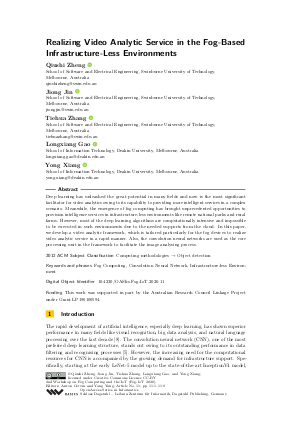Realizing Video Analytic Service in the Fog-Based Infrastructure-Less Environments
Authors
Qiushi Zheng  ,
Jiong Jin
,
Jiong Jin  ,
Tiehua Zhang
,
Tiehua Zhang  ,
Longxiang Gao
,
Longxiang Gao  ,
Yong Xiang
,
Yong Xiang 
-
Part of:
Volume:
2nd Workshop on Fog Computing and the IoT (Fog-IoT 2020)
Part of: Series: Open Access Series in Informatics (OASIcs)
Part of: Conference: Workshop on Fog Computing and the IoT (Fog-IoT) - License:
 Creative Commons Attribution 3.0 Unported license
Creative Commons Attribution 3.0 Unported license
- Publication Date: 2020-04-08
File

PDF
OASIcs.Fog-IoT.2020.11.pdf
- Filesize: 434 kB
- 9 pages
Document Identifiers
Subject Classification
ACM Subject Classification
- Computing methodologies → Object detection
Keywords
- Fog Computing
- Convolution Neural Network
- Infrastructure-less Environment
Metrics
- Access Statistics
-
Total Accesses (updated on a weekly basis)
0PDF Downloads0Metadata Views
Abstract
Deep learning has unleashed the great potential in many fields and now is the most significant facilitator for video analytics owing to its capability to providing more intelligent services in a complex scenario. Meanwhile, the emergence of fog computing has brought unprecedented opportunities to provision intelligence services in infrastructure-less environments like remote national parks and rural farms. However, most of the deep learning algorithms are computationally intensive and impossible to be executed in such environments due to the needed supports from the cloud. In this paper, we develop a video analytic framework, which is tailored particularly for the fog devices to realize video analytic service in a rapid manner. Also, the convolution neural networks are used as the core processing unit in the framework to facilitate the image analysing process.
Cite As Get BibTex
Qiushi Zheng, Jiong Jin, Tiehua Zhang, Longxiang Gao, and Yong Xiang. Realizing Video Analytic Service in the Fog-Based Infrastructure-Less Environments. In 2nd Workshop on Fog Computing and the IoT (Fog-IoT 2020). Open Access Series in Informatics (OASIcs), Volume 80, pp. 11:1-11:9, Schloss Dagstuhl – Leibniz-Zentrum für Informatik (2020)
https://doi.org/10.4230/OASIcs.Fog-IoT.2020.11
BibTex
@InProceedings{zheng_et_al:OASIcs.Fog-IoT.2020.11,
author = {Zheng, Qiushi and Jin, Jiong and Zhang, Tiehua and Gao, Longxiang and Xiang, Yong},
title = {{Realizing Video Analytic Service in the Fog-Based Infrastructure-Less Environments}},
booktitle = {2nd Workshop on Fog Computing and the IoT (Fog-IoT 2020)},
pages = {11:1--11:9},
series = {Open Access Series in Informatics (OASIcs)},
ISBN = {978-3-95977-144-3},
ISSN = {2190-6807},
year = {2020},
volume = {80},
editor = {Cervin, Anton and Yang, Yang},
publisher = {Schloss Dagstuhl -- Leibniz-Zentrum f{\"u}r Informatik},
address = {Dagstuhl, Germany},
URL = {https://drops.dagstuhl.de/entities/document/10.4230/OASIcs.Fog-IoT.2020.11},
URN = {urn:nbn:de:0030-drops-120050},
doi = {10.4230/OASIcs.Fog-IoT.2020.11},
annote = {Keywords: Fog Computing, Convolution Neural Network, Infrastructure-less Environment}
}
Author Details
- School of Software and Electrical Engineering, Swinburne University of Technology, Melbourne, Australia
- School of Software and Electrical Engineering, Swinburne University of Technology, Melbourne, Australia
- School of Software and Electrical Engineering, Swinburne University of Technology, Melbourne, Australia
Funding
This work was supported in part by the Australian Research Council Linkage Project under Grant LP190100594.
References
-
Martín Abadi, Paul Barham, Jianmin Chen, Zhifeng Chen, Andy Davis, Jeffrey Dean, Matthieu Devin, Sanjay Ghemawat, Geoffrey Irving, Michael Isard, et al. Tensorflow: A system for large-scale machine learning. In 12th USENIX Symposium on Operating Systems Design and Implementation (OSDI 16), pages 265-283, November 2016.

-
Flavio Bonomi, Rodolfo Milito, Jiang Zhu, and Sateesh Addepalli. Fog computing and its role in the internet of things. In Proceedings of the first edition of the MCC workshop on Mobile cloud computing, pages 13-16, August 2012.

-
Sumit Chopra, Raia Hadsell, and Yann LeCun. Learning a similarity metric discriminatively, with application to face verification. In 2005 IEEE Computer Society Conference on Computer Vision and Pattern Recognition (CVPR'05), volume 1, pages 539-546. IEEE, June 2005.

-
Australian Competition & Consumer Commission. Domestic mobile roaming declaration inquiry final report, 2017.

-
Alex Krizhevsky, Ilya Sutskever, and Geoffrey E Hinton. Imagenet classification with deep convolutional neural networks. In Advances in Neural Information Processing Systems 25 (NIPS 2012), pages 1097-1105, 2012.

-
He Li, Kaoru Ota, and Mianxiong Dong. Learning iot in edge: Deep learning for the internet of things with edge computing. IEEE Network, 32(1):96-101, January 2018.

-
Wei Liu, Dragomir Anguelov, Dumitru Erhan, Christian Szegedy, Scott Reed, Cheng-Yang Fu, and Alexander C Berg. Ssd: Single shot multibox detector. In European Conference on Computer Vision, pages 21-37. Springer, 2016.

-
Lingjuan Lyu, James C Bezdek, Xuanli He, and Jiong Jin. Fog-embedded deep learning for the internet of things. IEEE Transactions on Industrial Informatics, 15(7):4206-4215, July 2019.

- Australian Government Department of Agriculture. Land use in australia at a glance 2006. URL: https://www.agriculture.gov.au/sites/default/files/abares/aclump/documents/Land_use_in_Australia_at_a_glance_2006.pdf.
- Australia Government Department of the Environment and Energy. Capad 2016 national summary. URL: https://www.environment.gov.au/land/nrs/science/capad/2016.
-
Kari Pulli, Anatoly Baksheev, Kirill Kornyakov, and Victor Eruhimov. Real-time computer vision with opencv. Communications of the ACM, 55(6):61-69, June 2012.

-
Xukan Ran, Haolianz Chen, Xiaodan Zhu, Zhenming Liu, and Jiasi Chen. Deepdecision: A mobile deep learning framework for edge video analytics. In IEEE INFOCOM 2018-IEEE Conference on Computer Communications, pages 1421-1429. IEEE, April 2018.

-
Joseph Redmon, Santosh Divvala, Ross Girshick, and Ali Farhadi. You only look once: Unified, real-time object detection. In The IEEE Conference on Computer Vision and Pattern Recognition (CVPR), pages 779-788, June 2016.

-
Mark Sandler, Andrew Howard, Menglong Zhu, Andrey Zhmoginov, and Liang-Chieh Chen. Mobilenetv2: Inverted residuals and linear bottlenecks. In The IEEE Conference on Computer Vision and Pattern Recognition (CVPR), pages 4510-4520, June 2018.

-
Nishu Singla. Motion detection based on frame difference method. International Journal of Information & Computation Technology, 4(15):1559-1565, 2014.

-
Qiushi Zheng, Jiong Jin, Tiehua Zhang, Jianhua Li, Longxiang Gao, and Yong Xiang. Energy-sustainable fog system for mobile web services in infrastructure-less environments. IEEE Access, 7:161318-161328, 2019.

